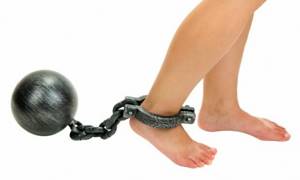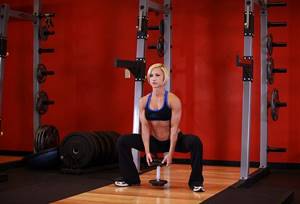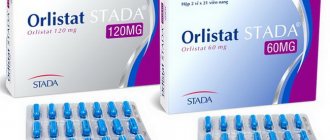Heavy leg syndrome: what is it and what are the reasons for its development?
Heavy leg syndrome is a condition in which the veins of the lower extremities undergo pathological transformation. Under normal conditions, venous valves control the movement of blood flow from the periphery to the heart and prevent the reverse flow of blood. However, under the influence of predisposing factors, the valves of the venous vessels do not cope with their task and a person develops varicose veins, which is the main cause of heavy leg syndrome. What are the prerequisites for its development?
heavy leg syndrome
Heavy leg syndrome - why does it occur?
- Hereditary predisposition. If parents or close relatives have varicose veins, then the tendency to problems with venous valves will be inherited.
- Physical inactivity. Lack of movement is one of the common causes of varicose veins. Many office workers and freelancers who spend most of the day at the computer suffer from this problem.
- Staying on your feet for a long time due to the characteristics of your professional activity. Salespeople, couriers, hairdressers, waiters and other people who are forced to spend all day on their feet often complain of the development of heavy leg syndrome.
- Prolonged immobilization. If a person is forced to spend a long time in bed (for example, after fractures or operations), he runs the risk of disrupting venous blood flow.
- Obesity. Excess weight puts additional pressure on the legs, which can cause the venous valves to malfunction.
- Pregnancy. According to statistics, every third woman experiences heavy leg syndrome during pregnancy. This prevalence of pathology is associated with increasing pressure on the legs, an increase in the volume of venous blood and changes in the hormonal levels of the expectant mother.
- Diseases of the cardiovascular system. Disturbances in the functioning of the heart valves, coronary heart disease, high cholesterol levels and other malfunctions of the cardiovascular system create the preconditions for the occurrence of heavy leg syndrome.
- Wrong lifestyle. Insufficient fluid intake, unbalanced diet, smoking and drinking alcohol, frequent wearing of tight trousers and high-heeled shoes - all this can lead to the development of varicose veins.
Expert opinion
According to statistics, about 10% of the adult population of developed countries suffers from heavy leg syndrome. This figure increases with age. As a result, the disorder affects approximately 15% of older adults.
Vascular surgeon, phlebologist
Osipova Ekaterina Yakovlevna
How to lose weight in your legs?
Good news for all coffee drinkers: A study in the American Journal of Clinical Nutrition found that overweight participants who regularly drink coffee have a better metabolism and therefore lose more weight than those who don't drink caffeine. Of course, coffee should be unsweetened and it is best to drink it without milk.
2. Exercises for games
In front of the mirror, while brushing your teeth, looking at your phone screen, or while cooking: Create a light load on your calves. Simply stand on your toes and then transfer your weight to your heels. Repeat 20 times.
Get into the habit of doing squats every day, and you will notice how your thighs become stronger and your legs become stronger and leaner. All parts of the legs benefit from squats: buttocks, thighs and calves. A German study published in the journal Sports Medicine also found that squats not only strengthen your knees, but also protect your joints.
If you've previously ignored this exercise or didn't know about it, it's time to incorporate the leg press into your fitness routine. The leg press helps train the muscles of the thighs, buttocks, calves and stimulates metabolism. You don't have to lift a lot of weight. Experts say light weight is also effective.
The lunge exercise may seem grueling, but it is very effective. Lunges train the muscles of the buttocks, calves and even thighs. Lunges also relax the tendons in your legs. Simply take a big step forward with your right foot and place your left knee on the floor. Then switch legs. Repeat 10 times.
Get used to walking. Researchers from the London School of Economics found that people who walk regularly have a lower BMI than those who do not walk on their own two feet. You can get off one stop early and walk the rest of the way. And go for a walk every weekend, preferably where there are a lot of trees and fresh air.
7. More calcium
The mineral is useful not only for bones, but also for muscle growth. Calcium helps muscles contract, which helps them grow.
Next time after exercising, eat some citrus fruit instead of a protein bar. Lemons, limes or oranges speed up fat burning, and the vitamin C they contain additionally has an anti-inflammatory effect.
9. Short intense workouts
One study published in the Journal of Obesity found that short, intense exercise was more effective than long-term endurance training (cardio). It turns out that it is better to engage in regular (once every 2 days) short 20-minute high-intensity training (for example, sprints) than to do long-term exercise with a low load.
Symptoms of Heavy Leg Syndrome
This pathology can be recognized by the following signs:
- The appearance of a characteristic vascular pattern on the legs: bluish “stars” and mesh. As heavy leg syndrome progresses, the veins become dilated.
- A feeling of pain, heaviness and fullness in the lower extremities, intensifying after a long stay in a static position and disappearing after a night's rest.
- Swelling of the legs and itchy skin.
- Spasmodic muscle contractions (especially in the evening and at night) are the main feature of restless legs syndrome (RLS), which is a type of heavy legs syndrome. Involuntary twitching of the limbs interferes with normal sleep, which is why patients complain of insomnia and fatigue during the day.
Expert opinion
These symptoms are most often ignored by most people for a long time. As a result, the disease progresses, the patient’s condition worsens - this can lead to complications of varicose veins, including thrombosis and thrombophlebitis. Therefore, do not ignore the symptoms that arise and go to see a doctor.
Vascular surgeon, phlebologist
Osipova Ekaterina Yakovlevna
Symptoms of lipedema: cellulite, swelling, etc.
You can suspect the presence of lipedema if you notice some of the signs listed above. The following signs should make a person wary:
- legs become fuller and fuller, despite dietary restrictions and an active lifestyle;
- legs react painfully to touch and pressure;
- even the slightest blow (for example, on the edge of a bed) is immediately accompanied by severe pain and large bruises;
- Often there is a feeling that the legs are filled with lead.
If these symptoms are detected, you should consult a phlebologist, lymphologist or angiologist to find out whether these signs are symptoms of existing lipedema.
Typical symptoms of lipedema are:
- Feeling of heaviness in the legs.
- Increased sensitivity of the skin of the feet.
- Swelling of the legs after prolonged standing or sitting.
- Cellulite.
- Painful lumps and knots under the skin.
- Tendency to bruise.
- Cold skin.
In the initial stage, lipedema manifests itself only as small nodules under the skin - a typical picture of cellulite.
In the second stage, the nodes enlarge and become painful.
In the third stage, the disease is characterized by large fatty bumps that stretch and deform the skin.
Lipedema can affect both individual regions of the body (for example, the thigh area - the famous “breeches”) and the entire limbs, characterized not only by very full legs, but also by significant swelling of the feet and toes.
Heavy Leg Syndrome: Treatment

If you experience the symptoms described above, do not delay a visit to a phlebologist. Self-medication is highly discouraged - it is better to trust specialists in the matter of therapy. The diagnosis is made based on a visual and physical examination of the patient, as well as data obtained from vascular ultrasound and duplex angioscanning.
To return blood vessels to normal tone and normalize valve function, the following methods are used:
- The use of phlebotropic drugs. These products help strengthen the walls of blood vessels and increase their elasticity, reduce swelling of the lower extremities and reduce their pain.
- Wearing compression garments. Special stockings, stockings and tights exert graduated pressure on the veins of the legs, normalizing the speed of blood flow and reducing swelling of the lower extremities.
- Surgical intervention. If the disease is at an early stage of development, laser or sclerotherapy is used to eliminate spider veins and spider veins. If the pathological process has reached an advanced stage, the patient may be recommended to undergo phlebectomy - surgical removal of areas of altered veins. Elective surgery is not performed in pregnant women, with severe arterial hypertension, deep vein thrombosis and certain heart diseases.
- Minimally invasive methods for treating heavy leg syndrome. If open surgery is not performed for any reason, and drug therapy has proven to be ineffective, methods for treating varicose veins without surgery are prescribed. For example, this could be sclerotherapy or radiofrequency ablation.
Preventing the development of heavy leg syndrome

Useful foods to prevent heavy leg syndrome
If you have the first signs of varicose veins, correct lifestyle and nutritional adjustments, combined with adherence to medical recommendations, will help return your legs to normal health. To achieve this, follow a few simple rules:
- Avoid wearing high heels frequently.
- It is recommended to make it a rule to do feasible physical exercises every day: stand on your toes, do “bicycle” and “scissors”, go swimming. At the same time, strength exercises with large weights, squats and jumps should be abandoned.
- If you are forced to spend a long time in a static position (for example, during a long air flight), periodically strain your calf muscles and lift your heels and toes off the floor. Literally a few of these mini-exercises can improve blood flow in the veins of the legs.
- Adjust your daily diet so that it contains foods rich in coarse plant fibers: these can be fresh vegetables, herbs, and fruits.
- Don't forget about your drinking regime: you need to drink at least 2 liters of clean water every day (this does not include tea, juices, broths).
- Avoid drinking alcohol, strong coffee, smoked and salty foods, trans fats, baked goods and bread, milk and dairy products, and sugar. Instead of these products, include vegetables, fruits and berries, legumes, sea fish and seafood, vegetable oils, nuts and seeds in your diet.
- Normaven® can be used to prevent the development of heavy leg syndrome. For example, Normaven® Foot Tonic is a great help for tired feet. The product has a beneficial effect on the blood vessels of the lower extremities, helping to cope with the feeling of heaviness and fullness that appears at the end of the day or during prolonged sitting. The toner contains natural ingredients: extracts of chestnut, witch hazel, butcher's broom, as well as menthol and panthenol. Highly qualified specialists, employees of the pharmaceutical company VERTEX, worked on the development of the product. Leg tonic Normaven® has a full package of relevant documents and certificates and is recommended for use in the initial stages of varicose veins development.
Cardio for weight loss
Running or swimming is one of the very first exercises that we use to combat excess fat in the legs. Both dry out thick legs perfectly, but everything goes according to plan exactly until the moment when the top becomes so thin that it’s scary to watch. A common complaint from women is: “By the time my thighs start losing weight, I won’t have any breasts left” or “My cheeks sunken in, when I tried to lose weight, it looked terrible.” And for men, the distribution of fat according to the “female pattern” is extremely depressing a priori.
In this regard, forums are filled with questions about how to burn fat only in a certain area, but we will have to dispel this myth. Unfortunately, in the process of burning fat, our body works as a single system, and you will not be able to lose weight locally. Does this mean that you can forget about cardio and it is ineffective? In no case!
- Do cardio for an hour in the morning and 20 minutes after strength training. It is advisable to turn it on 5 times a week.
- On exercise machines, choose the easiest mode, so the muscles will not strain and grow unnecessarily.
- Choose from running, brisk walking, swimming or the elliptical trainer. A bicycle and a stepper are not the best choice in your case.
“What about the anorexic top?” - you ask. You will have to work on it too.
If you don't like running, don't torture yourself. Not everyone knows how to run correctly, and the harm of improper running for the knees is enormous. Choose to walk at a brisk pace and it will be just as effective.

Video: Restless legs syndrome
is not responsible for the accuracy of the information presented in this video clip. Source – JitZdorovo
Sources:
- RESTLESS LEGS SYNDROME: PATHOGENESIS, DIAGNOSIS, TREATMENT. LITERATURE REVIEW. Kovalchuk M.O., Kalinkin A.L. // Neuromuscular diseases. – 2012. – No. 3. – P. 8-19.
- RESTLESS LEGS SYNDROME. Chamsaev M.A., Ivanichev G.A., Boyko S.P., Gainutdinov A.R., Staroseltseva N.G. // Kazan Medical Journal. – 2003. – No. 3. – pp. 186-193.
- MEDICAL REHABILITATION OF PHLEBOLOGICAL PATIENTS. Zhukov B.N., Katorkin S.E., Kostyaev V.E., Kostyaeva E.V. // Bulletin of new medical technologies. – 2009. – No. 4. – pp. 76-79.
- https://www.medicalnewstoday.com/articles/321670.php
- https://ru.scribd.com/document/13164531/Heavy-Leg-Syndrome-Article
For an accurate diagnosis, contact a specialist.
Fighting strategy against fat legs
Massive fat legs can ruin everyone's life, forcing you into clothes you don't like and forcing you to choose a lifestyle that squeezes out all your juices. If you are familiar with the problem of choosing decent jeans, and running in the morning is your daily curse, we don’t need to tell you how difficult it is to deal with those hated thighs. But we will tell you what can be done in such a situation.












